Abstract
BACKGROUND--Subjects with previous high altitude pulmonary oedema may have stronger than normal hypoxic pulmonary vasoconstriction. Susceptibility to high altitude pulmonary oedema may be detectable by echo Doppler assessment of the pulmonary vascular reactivity to breathing a hypoxic gas mixture at sea level. METHODS--The study included 20 healthy controls, seven subjects with a previous episode of high altitude pulmonary oedema, and nine who had successfully climbed to altitudes of 6000-8842 m during the 40th anniversary British expedition to Mount Everest. Echo Doppler measurements of pulmonary blood flow acceleration time (AT) and ejection time (ET), and of the peak velocity of the tricuspid regurgitation jet (TR), were obtained under normobaric conditions of normoxia (fraction of inspired oxygen, FIO2, 0.21), of hyperoxia (FIO2 1.0), and of hypoxia (FIO2 0.125). RESULTS--Hypoxia decreased AT/ET by mean (SE) 0.06 (0.01) in the control subjects, by 0.11 (0.01) in those susceptible to high altitude pulmonary oedema, and by 0.02 (0.02) in the successful high altitude climbers. Hypoxia increased TR in the three groups by 0.22 (0.06) (n = 14), 0.56 (0.13) (n = 5), and 0.18 (0.1) (n = 7) m/s, respectively. However, AT/ET and/or TR measurements outside the normal range, defined as mean +/- 2 SD of measurements obtained in the controls under hypoxia, were observed in only two of the subjects susceptible to high altitude pulmonary oedema and in five of the successful high altitude climbers. CONCLUSIONS--Pulmonary vascular reactivity to hypoxia is enhanced in subjects with previous high altitude pulmonary oedema and decreased in successful high altitude climbers. However, echo Doppler estimates of hypoxic pulmonary vaso-constriction at sea level cannot reliably identify subjects susceptible to high altitude pulmonary oedema or successful high altitude climbers from a normal control population.
Full text
PDF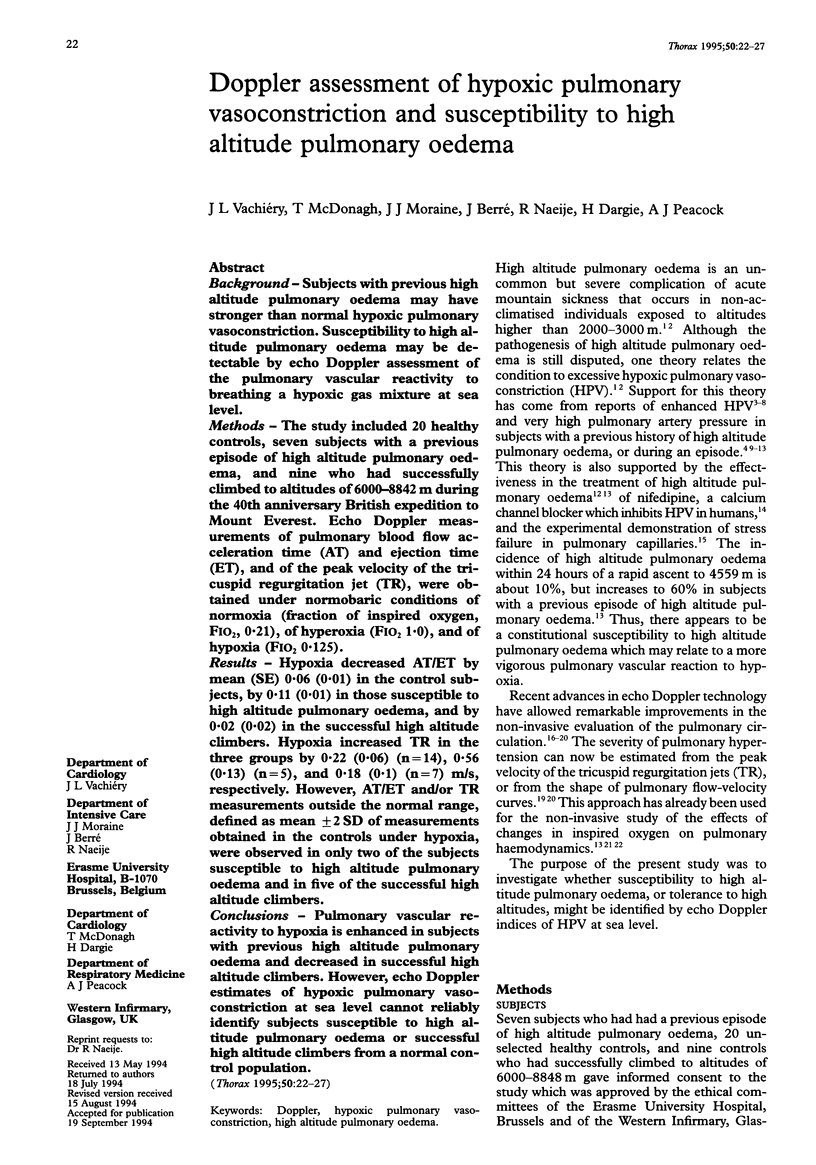

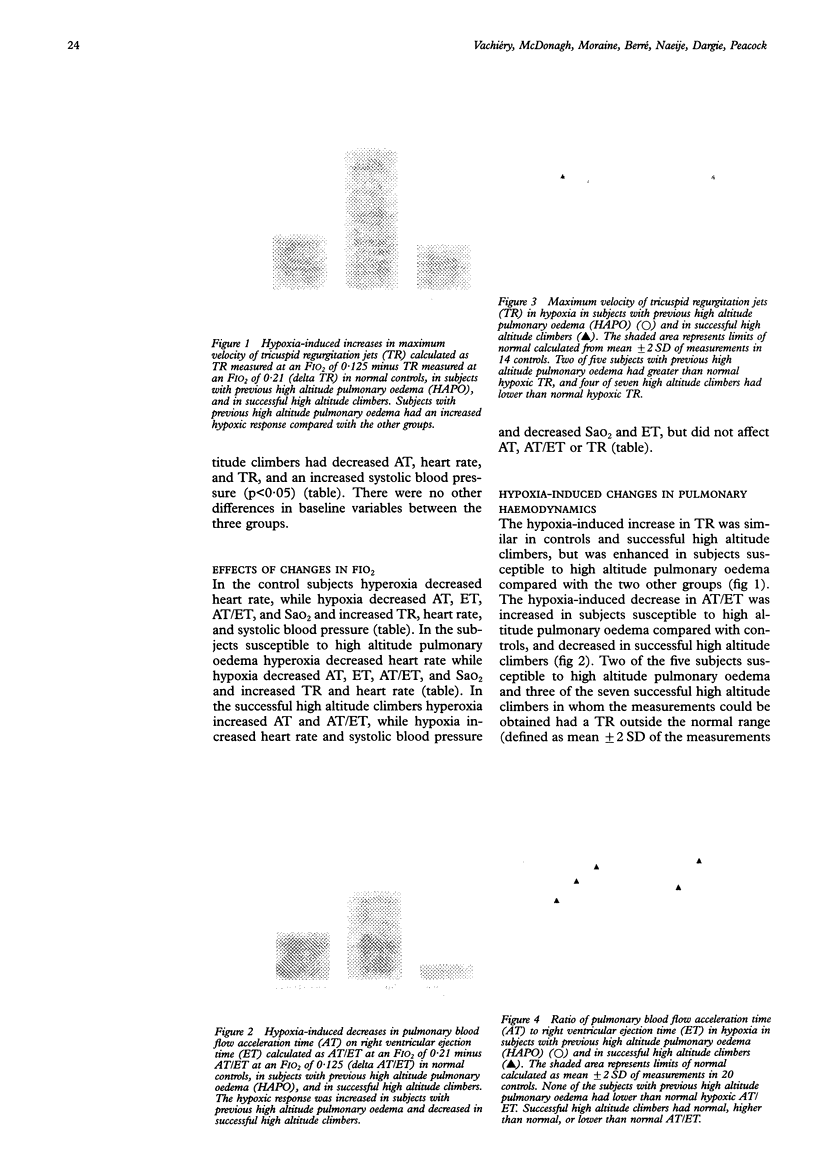
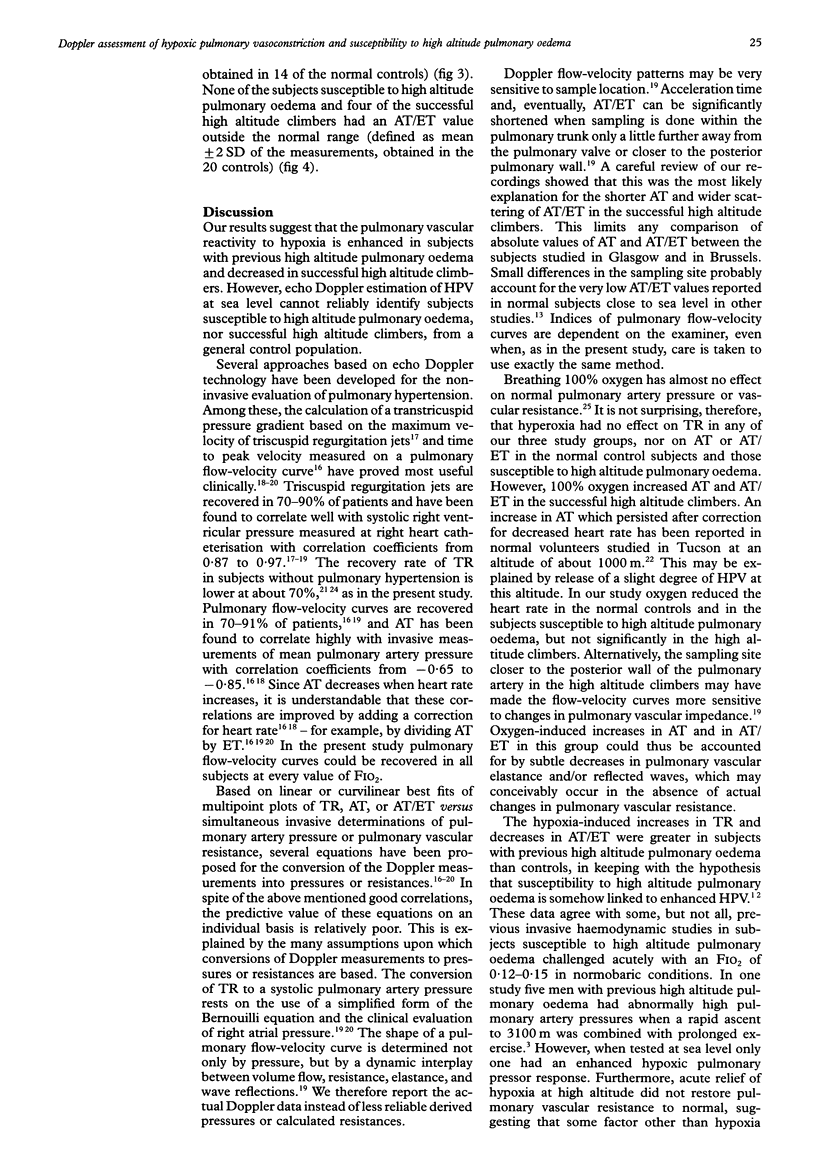
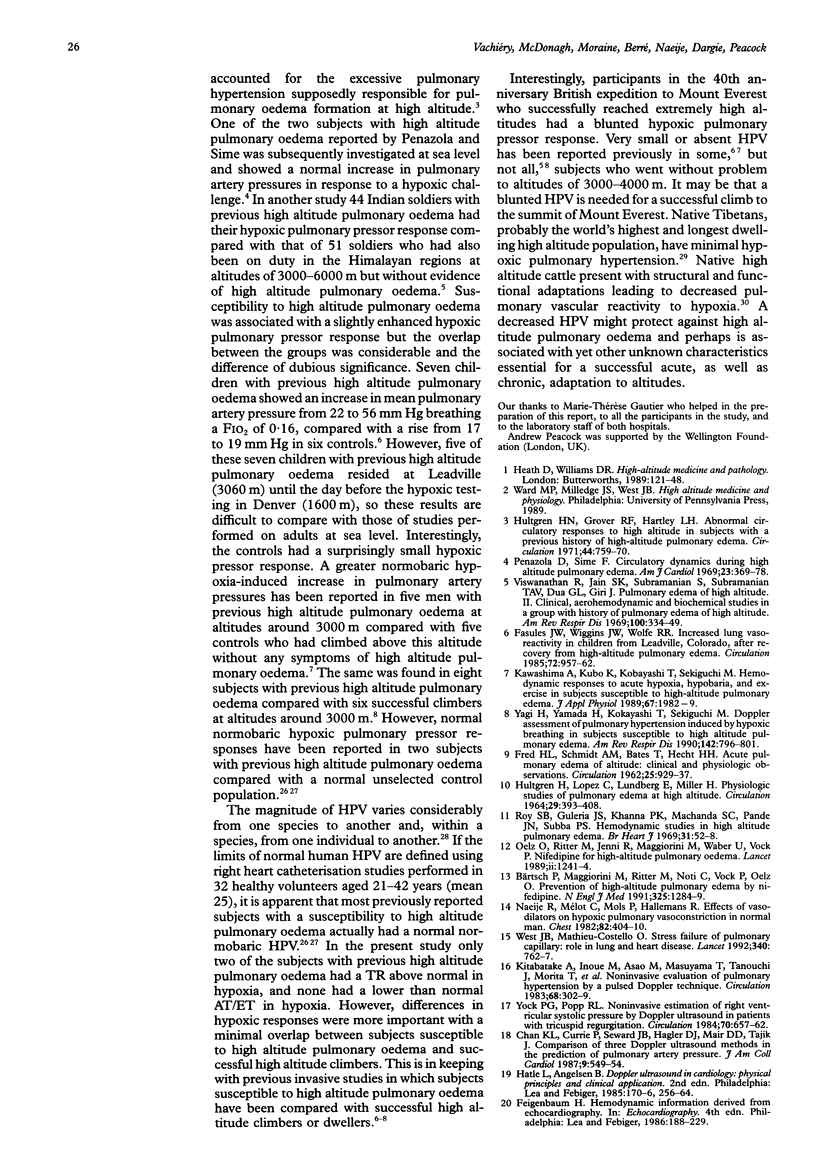
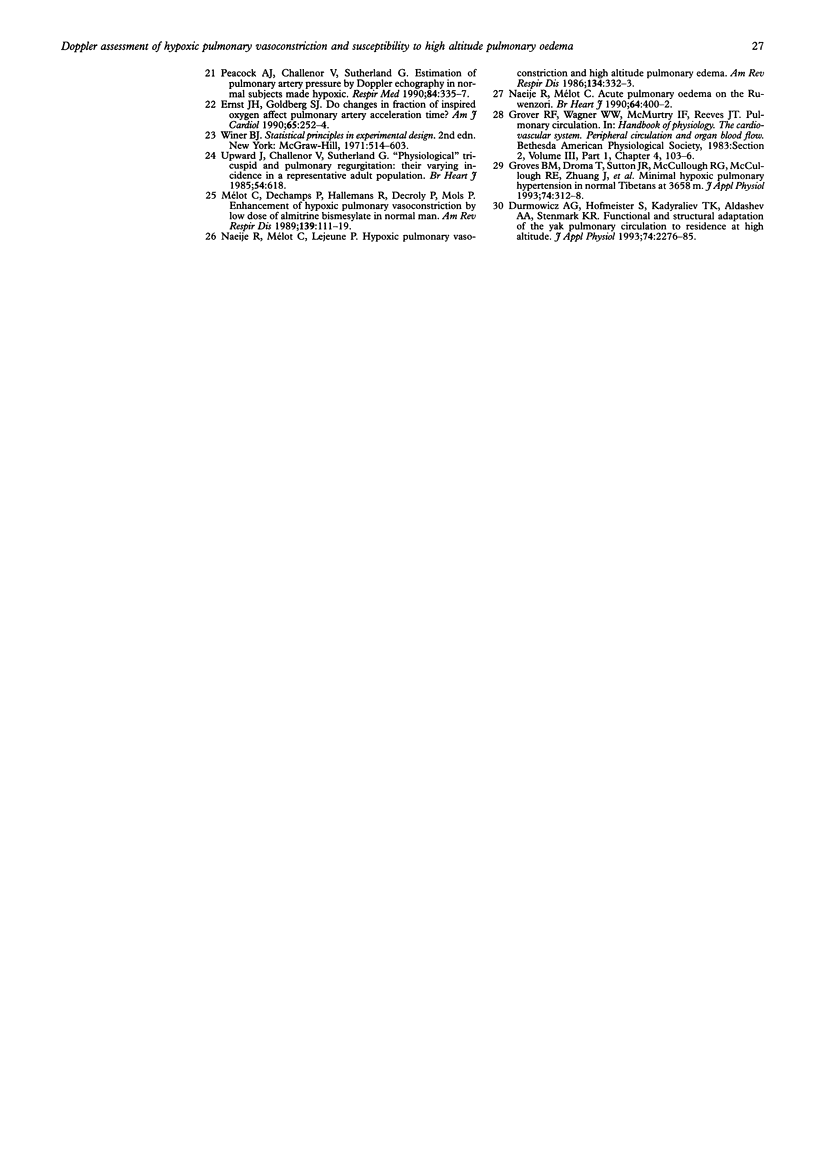
Images in this article
Selected References
These references are in PubMed. This may not be the complete list of references from this article.
- Chan K. L., Currie P. J., Seward J. B., Hagler D. J., Mair D. D., Tajik A. J. Comparison of three Doppler ultrasound methods in the prediction of pulmonary artery pressure. J Am Coll Cardiol. 1987 Mar;9(3):549–554. doi: 10.1016/s0735-1097(87)80047-5. [DOI] [PubMed] [Google Scholar]
- Durmowicz A. G., Hofmeister S., Kadyraliev T. K., Aldashev A. A., Stenmark K. R. Functional and structural adaptation of the yak pulmonary circulation to residence at high altitude. J Appl Physiol (1985) 1993 May;74(5):2276–2285. doi: 10.1152/jappl.1993.74.5.2276. [DOI] [PubMed] [Google Scholar]
- Ernst J. H., Goldberg S. J. Do changes in fraction of inspired oxygen affect pulmonary artery acceleration time? Am J Cardiol. 1990 Jan 15;65(3):252–254. doi: 10.1016/0002-9149(90)90096-j. [DOI] [PubMed] [Google Scholar]
- Fasules J. W., Wiggins J. W., Wolfe R. R. Increased lung vasoreactivity in children from Leadville, Colorado, after recovery from high-altitude pulmonary edema. Circulation. 1985 Nov;72(5):957–962. doi: 10.1161/01.cir.72.5.957. [DOI] [PubMed] [Google Scholar]
- Groves B. M., Droma T., Sutton J. R., McCullough R. G., McCullough R. E., Zhuang J., Rapmund G., Sun S., Janes C., Moore L. G. Minimal hypoxic pulmonary hypertension in normal Tibetans at 3,658 m. J Appl Physiol (1985) 1993 Jan;74(1):312–318. doi: 10.1152/jappl.1993.74.1.312. [DOI] [PubMed] [Google Scholar]
- HULTGREN H. N., LOPEZ C. E., LUNDBERG E., MILLER H. PHYSIOLOGIC STUDIES OF PULMONARY EDEMA AT HIGH ALTITUDE. Circulation. 1964 Mar;29:393–408. doi: 10.1161/01.cir.29.3.393. [DOI] [PubMed] [Google Scholar]
- Hultgren H. N., Grover R. F., Hartley L. H. Abnormal circulatory responses to high altitude in subjects with a previous history of high-altitude pulmonary edema. Circulation. 1971 Nov;44(5):759–770. doi: 10.1161/01.cir.44.5.759. [DOI] [PubMed] [Google Scholar]
- Kawashima A., Kubo K., Kobayashi T., Sekiguchi M. Hemodynamic responses to acute hypoxia, hypobaria, and exercise in subjects susceptible to high-altitude pulmonary edema. J Appl Physiol (1985) 1989 Nov;67(5):1982–1989. doi: 10.1152/jappl.1989.67.5.1982. [DOI] [PubMed] [Google Scholar]
- Kitabatake A., Inoue M., Asao M., Masuyama T., Tanouchi J., Morita T., Mishima M., Uematsu M., Shimazu T., Hori M. Noninvasive evaluation of pulmonary hypertension by a pulsed Doppler technique. Circulation. 1983 Aug;68(2):302–309. doi: 10.1161/01.cir.68.2.302. [DOI] [PubMed] [Google Scholar]
- Mélot C., Dechamps P., Hallemans R., Decroly P., Mols P. Enhancement of hypoxic pulmonary vasoconstriction by low dose almitrine bismesylate in normal humans. Am Rev Respir Dis. 1989 Jan;139(1):111–119. doi: 10.1164/ajrccm/139.1.111. [DOI] [PubMed] [Google Scholar]
- Naeije R., Mélot C. Acute pulmonary oedema on the Ruwenzori mountain range. Br Heart J. 1990 Dec;64(6):400–402. doi: 10.1136/hrt.64.6.400. [DOI] [PMC free article] [PubMed] [Google Scholar]
- Naeije R., Mélot C., Lejeune P. Hypoxic pulmonary vasoconstriction and high altitude pulmonary edema. Am Rev Respir Dis. 1986 Aug;134(2):332–333. doi: 10.1164/arrd.1986.134.2.332. [DOI] [PubMed] [Google Scholar]
- Naeije R., Mélot C., Mols P., Hallemans R. Effects of vasodilators on hypoxic pulmonary vasoconstriction in normal man. Chest. 1982 Oct;82(4):404–410. doi: 10.1378/chest.82.4.404. [DOI] [PubMed] [Google Scholar]
- Naeije R., Mélot C., Mols P., Hallemans R. Effects of vasodilators on hypoxic pulmonary vasoconstriction in normal man. Chest. 1982 Oct;82(4):404–410. doi: 10.1378/chest.82.4.404. [DOI] [PubMed] [Google Scholar]
- Oelz O., Maggiorini M., Ritter M., Waber U., Jenni R., Vock P., Bärtsch P. Nifedipine for high altitude pulmonary oedema. Lancet. 1989 Nov 25;2(8674):1241–1244. doi: 10.1016/s0140-6736(89)91851-5. [DOI] [PubMed] [Google Scholar]
- Peacock A. J., Challenor V., Sutherland G. Estimation of pulmonary artery pressure by Doppler echocardiography in normal subjects made hypoxic. Respir Med. 1990 Jul;84(4):335–337. doi: 10.1016/s0954-6111(08)80063-7. [DOI] [PubMed] [Google Scholar]
- Penaloza D., Sime F. Circulatory dynamics during high altitude pulmonary edema. Am J Cardiol. 1969 Mar;23(3):369–378. doi: 10.1016/0002-9149(69)90517-7. [DOI] [PubMed] [Google Scholar]
- Viswanathan R., Jain S. K., Subramanian S., Subramanian T. A., Dua G. L., Giri J. Pulmonary edema of high altitude. II. Clinical, aerohemodynamic, and biochemical studies in a group with history of pulmonary edema of high altitude. Am Rev Respir Dis. 1969 Sep;100(3):334–341. doi: 10.1164/arrd.1969.100.3.334. [DOI] [PubMed] [Google Scholar]
- West J. B., Mathieu-Costello O. Stress failure of pulmonary capillaries: role in lung and heart disease. Lancet. 1992 Sep 26;340(8822):762–767. doi: 10.1016/0140-6736(92)92301-u. [DOI] [PubMed] [Google Scholar]
- Yagi H., Yamada H., Kobayashi T., Sekiguchi M. Doppler assessment of pulmonary hypertension induced by hypoxic breathing in subjects susceptible to high altitude pulmonary edema. Am Rev Respir Dis. 1990 Oct;142(4):796–801. doi: 10.1164/ajrccm/142.4.796. [DOI] [PubMed] [Google Scholar]
- Yock P. G., Popp R. L. Noninvasive estimation of right ventricular systolic pressure by Doppler ultrasound in patients with tricuspid regurgitation. Circulation. 1984 Oct;70(4):657–662. doi: 10.1161/01.cir.70.4.657. [DOI] [PubMed] [Google Scholar]






